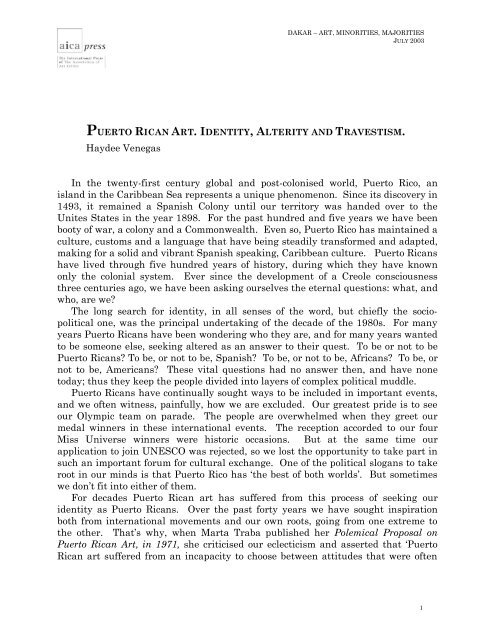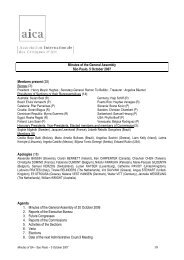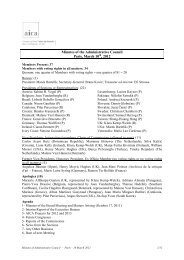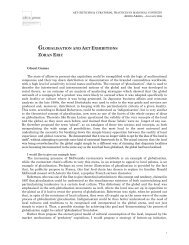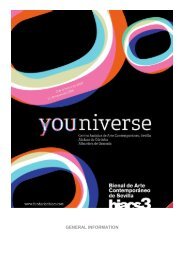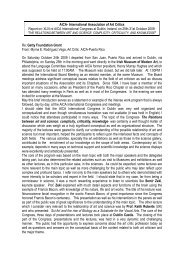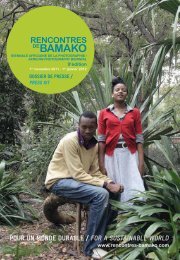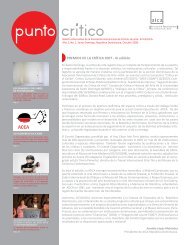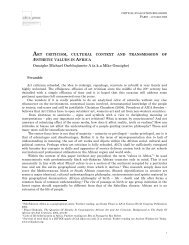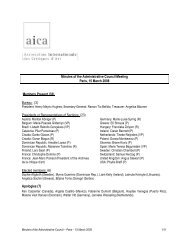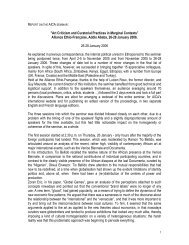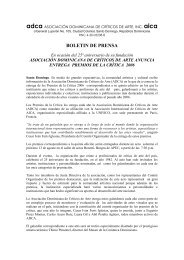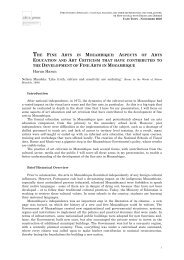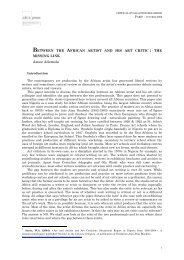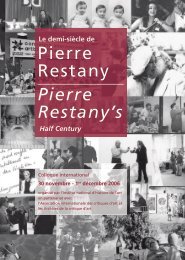Haydee Venegas In the twenty-first century ... - AICA international
Haydee Venegas In the twenty-first century ... - AICA international
Haydee Venegas In the twenty-first century ... - AICA international
You also want an ePaper? Increase the reach of your titles
YUMPU automatically turns print PDFs into web optimized ePapers that Google loves.
DAKAR – ART, MINORITIES, MAJORITIES<br />
JULY 2003<br />
PUERTO RICAN ART. IDENTITY, ALTERITY AND TRAVESTISM.<br />
<strong>Haydee</strong> <strong>Venegas</strong><br />
<strong>In</strong> <strong>the</strong> <strong>twenty</strong>-<strong>first</strong> <strong>century</strong> global and post-colonised world, Puerto Rico, an<br />
island in <strong>the</strong> Caribbean Sea represents a unique phenomenon. Since its discovery in<br />
1493, it remained a Spanish Colony until our territory was handed over to <strong>the</strong><br />
Unites States in <strong>the</strong> year 1898. For <strong>the</strong> past hundred and five years we have been<br />
booty of war, a colony and a Commonwealth. Even so, Puerto Rico has maintained a<br />
culture, customs and a language that have being steadily transformed and adapted,<br />
making for a solid and vibrant Spanish speaking, Caribbean culture. Puerto Ricans<br />
have lived through five hundred years of history, during which <strong>the</strong>y have known<br />
only <strong>the</strong> colonial system. Ever since <strong>the</strong> development of a Creole consciousness<br />
three centuries ago, we have been asking ourselves <strong>the</strong> eternal questions: what, and<br />
who, are we?<br />
The long search for identity, in all senses of <strong>the</strong> word, but chiefly <strong>the</strong> sociopolitical<br />
one, was <strong>the</strong> principal undertaking of <strong>the</strong> decade of <strong>the</strong> 1980s. For many<br />
years Puerto Ricans have been wondering who <strong>the</strong>y are, and for many years wanted<br />
to be someone else, seeking altered as an answer to <strong>the</strong>ir quest. To be or not to be<br />
Puerto Ricans? To be, or not to be, Spanish? To be, or not to be, Africans? To be, or<br />
not to be, Americans? These vital questions had no answer <strong>the</strong>n, and have none<br />
today; thus <strong>the</strong>y keep <strong>the</strong> people divided into layers of complex political muddle.<br />
Puerto Ricans have continually sought ways to be included in important events,<br />
and we often witness, painfully, how we are excluded. Our greatest pride is to see<br />
our Olympic team on parade. The people are overwhelmed when <strong>the</strong>y greet our<br />
medal winners in <strong>the</strong>se <strong>international</strong> events. The reception accorded to our four<br />
Miss Universe winners were historic occasions. But at <strong>the</strong> same time our<br />
application to join UNESCO was rejected, so we lost <strong>the</strong> opportunity to take part in<br />
such an important forum for cultural exchange. One of <strong>the</strong> political slogans to take<br />
root in our minds is that Puerto Rico has ‘<strong>the</strong> best of both worlds’. But sometimes<br />
we don’t fit into ei<strong>the</strong>r of <strong>the</strong>m.<br />
For decades Puerto Rican art has suffered from this process of seeking our<br />
identity as Puerto Ricans. Over <strong>the</strong> past forty years we have sought inspiration<br />
both from <strong>international</strong> movements and our own roots, going from one extreme to<br />
<strong>the</strong> o<strong>the</strong>r. That’s why, when Marta Traba published her Polemical Proposal on<br />
Puerto Rican Art, in 1971, she criticised our eclecticism and asserted that ‘Puerto<br />
Rican art suffered from an incapacity to choose between attitudes that were often<br />
1
DAKAR – ART, MINORITIES, MAJORITIES<br />
JULY 2003<br />
antagonistic’ 1 – namely, those that suited a peculiar system of belief. <strong>In</strong> contrast,<br />
Edward Lucie-Smith excluded Puerto Rico altoge<strong>the</strong>r from his book Twentieth<br />
Century Latin American Art (1993), claiming that ‘it is difficult to draw an<br />
absolutely firm line between twentieth-<strong>century</strong> Puerto Rican art and that of <strong>the</strong><br />
United States’. 2<br />
<strong>In</strong> spite of everything, I can affirm that in <strong>the</strong>se last four decades <strong>the</strong>re have<br />
been brilliant artists, who have overcome <strong>the</strong> frontiers of colonialisms and/or<br />
o<strong>the</strong>rness, and who have produced art with character, drama and au<strong>the</strong>nticity.<br />
A decade after <strong>the</strong> publication of Marta Traba’s book, great changes were afoot.<br />
The year 1984 was an important one, marking <strong>the</strong> beginning of a sea change. This<br />
was <strong>the</strong> year when <strong>the</strong> respected painter, Antonio Martorell, returned from six years<br />
in Mexico; and <strong>the</strong> young artists, Maria Mater O’Neill and Arnaldo Roche, obtained<br />
<strong>the</strong>ir degrees in art and also set foot on <strong>the</strong> island. These three artists took an<br />
active part in <strong>the</strong> artistic scene, while also helping to streng<strong>the</strong>n <strong>the</strong> art market.<br />
Carlos Collazo, who had never left <strong>the</strong> island, teamed up with O’Neill. During <strong>the</strong><br />
next two years Nick Quijano, Néstor Otero and Néstor Millán also returned, after<br />
pursuing successful careers in New York. <strong>In</strong> <strong>the</strong>ir search for identity, <strong>the</strong>se artists<br />
began to reinvent <strong>the</strong>mselves from <strong>the</strong> mid-1980s onwards, by adopting different<br />
guises and revealing <strong>the</strong>ir chameleon-like ability to change <strong>the</strong>ir artistic persona.<br />
The best example of this was Arnaldo Roche’s trilogy of self portraits, in which he<br />
portrayed himself as a black person with blue eyes, or as a white person with<br />
crinkly, blond hair.<br />
<strong>In</strong> <strong>the</strong> early 1990s Puerto Rican artists drew strength from <strong>the</strong> effervescence of<br />
<strong>the</strong> 1980s. Commercial galleries began to promote local artists and started to<br />
participate in <strong>international</strong> events. The number of major private collectors grew,<br />
and for <strong>the</strong> <strong>first</strong> time demand matched production. The celebration of <strong>the</strong> 500 th<br />
anniversaries of <strong>the</strong> discovery of America (1992) and Puerto Rico (1993), <strong>the</strong><br />
construction of a Puerto Rican Pavilion for EXPO’ 92 in Seville, Spain and <strong>the</strong><br />
staging of <strong>AICA</strong>’s Annual Congress in Puerto Rico all offered pretexts for mounting<br />
some memorable exhibitions. The opening of <strong>the</strong> Museo de Arte Contemporáneo also<br />
made a major contribution to <strong>the</strong> local art scene during this decade. Likewise, <strong>the</strong><br />
Escuela de Artes Plásticas became <strong>the</strong> production centre for an entire new<br />
generation of young artists, who are now <strong>the</strong> ones to be making waves. The 1990s<br />
brought even greater freedom - and problems - as <strong>the</strong> new millennium approached:<br />
spurred on by <strong>the</strong> celebrations of <strong>the</strong> centenary of <strong>the</strong> U.S. invasion, our artists now<br />
felt an obligation to re-examine our roots and try to get to grips with our hybrid<br />
character, as a people. Given <strong>the</strong> controversial nature of any attempt at a political<br />
definition of nationhood, <strong>the</strong>y adopted a variety of postures, turning <strong>the</strong>mselves into<br />
chameleons, changing identities and transgressing genres. This cross-dressing of<br />
identities was deliberate, but uncomfortable.<br />
1 Marta Traba, Propuesta polémica sobre arte puertorrique o. San Juan, Libreria <strong>In</strong>ternacional, <strong>In</strong>c., 1971, p. 11<br />
2 Edward Lucie-Smith, Latin American Art of <strong>the</strong> 20 th Century. London, Thames & Hudson, 1993, p. 8.<br />
2
DAKAR – ART, MINORITIES, MAJORITIES<br />
JULY 2003<br />
Puerto Ricans also sought to follow new paths. Spanglish (<strong>the</strong> mixing of Spanish<br />
and English words) started to fall in disuse. There was an effort to get rid of <strong>the</strong>se<br />
invented words and to speak a better Spanish. Educated Puerto Ricans, and even<br />
writers, now interject whole sentences or paragraphs in English, before returning to<br />
a grammatically correct Spanish. We switch back and forth between languages with<br />
great naturalness and are often unaware of what we are doing. <strong>In</strong> our effort to<br />
survive as a Caribbean people, we accept this cultural dualism, or fragmentation, to<br />
which we have been party for <strong>the</strong> past hundred years.<br />
An analogous dualism was to be found in some traditional African groups, who<br />
were forced to practise a special type of syncretism, by worshipping <strong>the</strong>ir own idols<br />
in <strong>the</strong> guise of catholic saints, as a means of preserving <strong>the</strong>ir own religion. And<br />
today we can even find proof that you can be two or more things at once, in <strong>the</strong> socalled<br />
‘transformer’ toys, featuring a car, a toy or a monster; or in holograms that<br />
allow us to switch between different reflected images, as we change position. Today,<br />
<strong>the</strong> marvels of design and technology make very plain <strong>the</strong> ease with which is<br />
possible to represent two or three different things at <strong>the</strong> same time.<br />
One thing is certain: we were always multi-mulatto, on this most hybrid of all<br />
Caribbean islands. We are part of that mixture of races and tongues that has<br />
existed in <strong>the</strong> Caribbean for <strong>the</strong> past 500 years; we experience to <strong>the</strong> full <strong>the</strong><br />
contradictions of being Puerto Rican, speaking Spanish, feeling we’re Latin<br />
Americans and carrying a U.S. passport. The blood of three races courses through<br />
our veins. When those of us with <strong>the</strong> even <strong>the</strong> fairest of skins hear <strong>the</strong> beat of <strong>the</strong><br />
drums we immediately begin to adopt a new posture, and our straight hair begins to<br />
curl up at <strong>the</strong> roots. La bomba, la plena, la salsa and now <strong>the</strong> raegetón are parts of<br />
<strong>the</strong> tradition that we now export. But we must eat paella from time to time, to<br />
remind us of our Hispanic roots. We have been active in defence of <strong>the</strong> Spanish<br />
language for over one hundred years of autonomous existence. But today our<br />
traditions also include taking <strong>the</strong> kids to McDonalds after Sunday mass, watching<br />
North American cable TV and listening to rock.<br />
Given <strong>the</strong> impossibility – or <strong>the</strong> futility - of trying to define a unique identity, <strong>the</strong><br />
<strong>twenty</strong>-<strong>first</strong> <strong>century</strong> Puerto Rican has discovered that <strong>the</strong> answer to our identity<br />
crisis is ‘to be, and to be’ This is where our visual artists, in keeping with <strong>the</strong>ir<br />
visionary mission, offer us a wide range of hybrid alternatives.<br />
And, in a way, isn’t <strong>the</strong> rest of <strong>the</strong> world heading in <strong>the</strong> same direction?<br />
‘Britain has become not only a multicultural nation but also one of mixed-race<br />
individuals, couples and families. The artists are beginning to reflect this<br />
complexity.’ 3<br />
Puerto Rico and Cuba have disputed <strong>the</strong> nationality of three of <strong>the</strong>ir children,<br />
Cuban by birth but brought up in Puerto Rico: Félix González Torres, Rosa Irigoyen<br />
and Ernesto Pujol. All three studied at <strong>the</strong> University of Puerto Rico. <strong>In</strong> <strong>the</strong>ir work,<br />
Irigoyen and Pujol both examine <strong>the</strong>ir childhoods in Cuba, <strong>the</strong> problems that led to<br />
3 Michael Kimmelman, in The New York Times, July 21, 2002<br />
3
DAKAR – ART, MINORITIES, MAJORITIES<br />
JULY 2003<br />
<strong>the</strong>ir migration and <strong>the</strong>ir cultural adaptation to <strong>the</strong>ir new environment. They have<br />
created similar codes for dealing with <strong>the</strong>e issues – one, in an almost classical style,<br />
<strong>the</strong> o<strong>the</strong>r in a baroque manner – and <strong>the</strong>y use <strong>the</strong> same images of airplanes,<br />
suitcases and palm trees.<br />
Most of Irigoyen’s installations have dealt with her departure from Cuba and<br />
subsequent return to <strong>the</strong> island. She even created her own passport to memory: <strong>the</strong><br />
illusions and memories destroyed, <strong>the</strong> country lost, <strong>the</strong> family dispersed, <strong>the</strong> dual<br />
mores. Her work is a never-ending journey, an all-encompassing view of <strong>the</strong><br />
Caribbean world, and a fluid transition from one state to ano<strong>the</strong>r. Her two latest<br />
works are even more personal. Last year she created and printed images from her<br />
memory onto rolls of paper hanging from paper towel dispensers. These were<br />
memories that could be disposed of. For three months this year, she started wearing<br />
extremely long and elaborately decorated false nails and documented <strong>the</strong> difficulties<br />
<strong>the</strong>se presented for daily life.<br />
Ernesto Pujol, after graduating from university spent thirteen years in a<br />
Cartesian monastery, <strong>the</strong>n moved to New York, to work as an artist. He also went<br />
to Cuba, to decipher <strong>the</strong> macho patriarchal culture of <strong>the</strong> white oligarchy into which<br />
he had been born. Back in Puerto Rico, he tried to recover <strong>the</strong> contradictory<br />
memories of his childhood and adolescence in a bi-cultural country, where in order<br />
to become a macho Puerto Rican, he had to play cowboys and <strong>In</strong>dians. Now he<br />
makes poetic photos, dressed up as a nun or a monk.<br />
Charles Juhasz-Alvarado, a strange case of a hybrid artist, born in Philippines of<br />
an Austrian fa<strong>the</strong>r and a Puerto Rican mo<strong>the</strong>r, was brought up in Japan, <strong>the</strong><br />
Dominican Republic and Puerto Rico. After gaining his Master’s degree in fine arts<br />
at Yale University, he returned to <strong>the</strong> island to teach at <strong>the</strong> Escuela de Artes<br />
Plásticas, in 1995. Ever since <strong>the</strong>n, his work has dealt with transgression, including<br />
transgression of <strong>the</strong> ordinary meaning of objects and <strong>the</strong> uses to which <strong>the</strong>y are put.<br />
As an artist, he is both highly intellectual and daring, and bold and defiant.<br />
Travestoys, <strong>the</strong> project he completed for his Master’s degree, is made up of three<br />
components that interact with <strong>the</strong> public: <strong>the</strong> skeleton of a huge wooden toy model of<br />
a German Focke-Wolf aeroplane, zooming in for a ‘kamikaze’ attack; Hammond<br />
Hall, <strong>the</strong> Yale building housing <strong>the</strong> sculpture department, here converted into a<br />
modern bro<strong>the</strong>l and presented as <strong>the</strong> object of <strong>the</strong> attack; and <strong>the</strong> rooms of <strong>the</strong><br />
bro<strong>the</strong>l itself, represented by ten drawers, each by a different Puerto Rican artist,<br />
invited by Juhasz-Alvarado himself to ‘infiltrate’ his work.<br />
or many years Juhasz-Alvado was fascinated by <strong>the</strong> ‘comejénes’, or tropical<br />
termites, those tireless sculptors in wood, who work in dark tunnels and devour<br />
everything that lies in <strong>the</strong>ir path. Whilst generally regarded as pests, in fact <strong>the</strong>y<br />
are a vital part of <strong>the</strong> tropical ecosystem, since <strong>the</strong>y attack only sick trees. He says<br />
that: ‘<strong>the</strong> “comején” has long served as a metaphor for <strong>the</strong> Puerto Rican imagination:<br />
Our culture keeps developing intensively, even under <strong>the</strong> aggressive influence of<br />
4
DAKAR – ART, MINORITIES, MAJORITIES<br />
JULY 2003<br />
imperialist policies of assimilation and cultural homogenization’. 4 Physically,<br />
Juhasz-Alvarado works from <strong>the</strong> ‘o<strong>the</strong>r side’. He creates objects culled from<br />
nor<strong>the</strong>rn cultures, disguises <strong>the</strong>m and infiltrates <strong>the</strong>m, in such a way that <strong>the</strong>y<br />
appear to be purely Caribbean. <strong>In</strong>filtration is <strong>the</strong> key to his work. It is not just that<br />
he regularly invites o<strong>the</strong>r artists to intervene in it; he also plays with trespassing on<br />
o<strong>the</strong>r types of frontier and invokes certain rites of passage. <strong>In</strong> 1999 he presented<br />
Tu-Tran, an installation dedicated to <strong>the</strong> San Juan metro, <strong>the</strong>n under construction.<br />
This consisted of a look-out post, with binoculars for viewing all <strong>the</strong> train stations,<br />
each one created by a different artist. Two of his latest works have dealt with illegal<br />
immigration of Dominicans into Puerto Rico and <strong>the</strong>ir attempts to smuggle<br />
forbidden fruits through <strong>the</strong> US customs. <strong>In</strong> both instances, he creates <strong>the</strong> aura of<br />
a fantastic voyage, both through <strong>the</strong> images <strong>the</strong>mselves and through <strong>the</strong> imaginary<br />
accounts that he incorporates into <strong>the</strong> accompanying texts. He deploys a complex<br />
array of colourful forms and structures, which assail <strong>the</strong> spectator on all fronts. <strong>In</strong><br />
<strong>the</strong> process, his work has become more colourful, poetic and purely Caribbean.<br />
Javier Cambre also works with hybrid installations. For his contribution to <strong>the</strong><br />
Whitney Biennial, Cambre cut a fritter vendor’s hut on a San Juan beach into two<br />
halves. He attached a white post-modernist structure to <strong>the</strong> half that remained on<br />
<strong>the</strong> beach and dispatched <strong>the</strong> o<strong>the</strong>r half of <strong>the</strong> hut to <strong>the</strong> exhibition in New York,<br />
where he joined it up to a similar contemporary structure. The resulting, modernist<br />
structure is an interpretation of <strong>the</strong> museum’s windows. Both hybrid structures<br />
speak for tradition and <strong>the</strong> modernity, for <strong>the</strong> here and <strong>the</strong> <strong>the</strong>re, and for two<br />
cultures and two worlds living in <strong>the</strong> same dimension.<br />
After obtaining a degree in law, José Lerma turned back to art. His works deal<br />
with relationships, changes and transpositions. He built a square room out of foam<br />
that can be mounted anywhere, so <strong>the</strong> viewer is encouraged to reflect on <strong>the</strong> nature<br />
of <strong>the</strong> specific site into which <strong>the</strong> room has been inserted. <strong>In</strong>stead of making people<br />
go to <strong>the</strong> museum, he builds <strong>the</strong> museum around ordinary situations. Ordinary or<br />
extraordinary objects and places can be seen differently, and reflected upon.<br />
Ano<strong>the</strong>r of his works involved converting a station wagon into a corvette. The<br />
classic family car was thus dressed up into <strong>the</strong> kind of vehicle suited to expressing a<br />
typical male’s mid-life crisis. This work dealt with family crisis. At Art Basel Miami<br />
he got hold of a copy of <strong>the</strong> catalogue and used a two-inch brush impregnated with<br />
polish remover to pick up all <strong>the</strong> images printed on its pages and transfer <strong>the</strong>m onto<br />
<strong>the</strong> walls of <strong>the</strong> gallery...<br />
Three young painters have emerged during <strong>the</strong> past five years. Rabindranath<br />
Diaz has always incorporated humour and sarcasm into his work. Now he is<br />
making beautiful triptychs, with complicated meanings. Their titles, made up of<br />
indecipherable phrases in Spanish and English, are as intelligent and enigmatic as<br />
<strong>the</strong> forms and colours of his triptychs. Ivelisse Jiménez works with layers and<br />
layers of images, and her abstract paintings are as complicated as <strong>the</strong> society we live<br />
4 Conversation with <strong>the</strong> author, n.d<br />
5
DAKAR – ART, MINORITIES, MAJORITIES<br />
JULY 2003<br />
in. Bright colours and forms painted over transparent materials create a<br />
mysterious, yet mystical, atmosphere. Miguel Trelles, for his part, has delved into<br />
Asian aes<strong>the</strong>tics, from <strong>the</strong> Far East and come up with Chinese look-alike<br />
landscapes, composed with <strong>the</strong> aid of a Caribbean colour-box. His Sino-Latino series<br />
is a journey into this fascinating culture of <strong>the</strong> ‘O<strong>the</strong>r’. It opens up new dimensions<br />
to our chameleon-like behaviour.<br />
Two young women make outstanding installations. Ada Bobonis works with<br />
architecture and <strong>the</strong> environment and creates poetic landscapes with <strong>the</strong>se elements<br />
indoors. <strong>In</strong> one of <strong>the</strong>se, a meadow hangs from <strong>the</strong> ceiling; whilst in ano<strong>the</strong>r, a<br />
rainforest is fitted to a window. <strong>In</strong> ano<strong>the</strong>r work, she takes <strong>the</strong> strands of a rope<br />
apart and dyes <strong>the</strong>m. Through painstaking procedures, such as this, she succeeds in<br />
bringing her artificial landscapes to life. <strong>In</strong> contrast, Marta Mabel Pérez deals<br />
directly with <strong>the</strong> multiple tribulations of society. Many of our problems are keenly<br />
presented <strong>the</strong>re. <strong>In</strong> ‘Hay que echar un pie’ [Lets Get Out Of Here] she present a<br />
piece of paper, with her portrait on one side and instructions on how to make a<br />
paper ’plane, on <strong>the</strong> o<strong>the</strong>r. The spectator <strong>the</strong>n has to throw <strong>the</strong> ’plane into <strong>the</strong> area<br />
which s/he would like to explore. For ‘Enfrascados’ [Bottled Up], she printed over a<br />
hundred images of <strong>the</strong> various problems afflicting <strong>the</strong> island and <strong>the</strong>n requested<br />
passers-by in <strong>the</strong> streets to place <strong>the</strong> image that seemed most apposite to <strong>the</strong>m into<br />
<strong>the</strong> bottle. Then she made a photo of <strong>the</strong> person holding <strong>the</strong> bottle in <strong>the</strong>ir hands.<br />
Beatriz Santiago is <strong>the</strong> most radical and intelligent of <strong>the</strong> video artists. She<br />
works with forgotten histories or everyday reality. For her videos she asks passersby<br />
to perform an action, while she films <strong>the</strong> event. For one of <strong>the</strong>se, she selected<br />
seven different events, that had seemed important at <strong>the</strong> time, but had now been<br />
forgotten: <strong>the</strong> killing of a notorious fugitive; placing bets on horses on <strong>the</strong> old<br />
racetrack, now converted into a highway; a night out at a famous dance hall from<br />
<strong>the</strong> forties; Karl Walenda’s fall to his death, and so on. She <strong>the</strong>n went on to present<br />
several of <strong>the</strong>se, as performances. For ‘Useful, Useless Factory’ she worked with<br />
factory débris, in every sense of <strong>the</strong> term. She built up a film set from discarded<br />
packing materials; <strong>the</strong>n she made a video, after interviewing many of <strong>the</strong> workers,<br />
in which she recounted <strong>the</strong>ir dreams, <strong>the</strong>ir fears and <strong>the</strong>ir extra-curricular<br />
activities, such as wrestling after lunch, holding a dance, or organising a party with<br />
typical food. She even staged <strong>the</strong> announcement of <strong>the</strong> factory’s closure.<br />
The last four artists that I want to talk about emerged around <strong>the</strong> turn of <strong>the</strong><br />
millennium and have been dubbed ‘Los Novisimos’ by <strong>the</strong> critic, Manuel Alvarez<br />
Lezama. All of <strong>the</strong>m graduated from <strong>the</strong> Escuela de Artes Plásticas.<br />
Aaron Salavarias began his career as an engraver, combining religious <strong>the</strong>mes<br />
with elements from daily life, in dark, monochromatic surroundings. Upon<br />
returning with his Master Degree from New York, he ventured into <strong>the</strong> medium of<br />
installation and began adding colour to his works. Now he seems to play with<br />
variations on <strong>the</strong> <strong>the</strong>me of life in Paradise. But his Paradise is a fake one.<br />
Performers have to dress up in an assortment of ridiculous clothing and act as if<br />
<strong>the</strong>y are enjoying <strong>the</strong> colourful Caribbean. By dressing <strong>the</strong> locals up as tourists, he<br />
6
DAKAR – ART, MINORITIES, MAJORITIES<br />
JULY 2003<br />
makes a statement about <strong>the</strong> nature of Paradise Lost. We see people posing proudly<br />
in front of plastic pools and plastic plants, with plastic toys in <strong>the</strong>ir hands; fat,<br />
skinny, young, old - <strong>the</strong>y all become members of <strong>the</strong> cast in a surreal form of pseudo-<br />
Paradise.<br />
Carlos Rivera is obsessed with <strong>the</strong> high crime rates in Puerto Rico. His work is<br />
drenched with an all-pervasive atmosphere of crime and revels in horrifying crimes,<br />
guns, drug dealers’ haunts, killers and all kinds or criminal paraphernalia. Rivera<br />
continuously confronts us with <strong>the</strong> violent reality of street life in this fake Paradise<br />
Chemi Rosado Seijo is also interested in <strong>the</strong> double entendres of our society. He<br />
covers up things, so we can see <strong>the</strong>m better. He tampers with billboards, by<br />
covering up some of <strong>the</strong> words, so that we come to suspect what is revealed as <strong>the</strong><br />
real truth behind <strong>the</strong> original message. His biggest and most important project, to<br />
date, was to paint all 200 houses in a mountain village <strong>the</strong> colour green. More<br />
precisely, he persuaded <strong>the</strong> residents of a whole community to paint <strong>the</strong>ir houses in<br />
different shades of green. He has spent <strong>the</strong> last two years working toge<strong>the</strong>r with <strong>the</strong><br />
community. Besides encouraging people to paint <strong>the</strong>ir houses, he has introduced a<br />
variety of o<strong>the</strong>r projects into <strong>the</strong> community, and a large variety of social workers,<br />
musicians and o<strong>the</strong>r kinds of artist have worked toge<strong>the</strong>r with residents, to produce<br />
t-shirts and murals.<br />
Guillermo Calzadilla is a very intense, highly intellectual young man who, with<br />
his partner Jennifer Allora, works under <strong>the</strong> joint name of Allora y Calzadilla.<br />
Allora y Calzadilla’s main <strong>the</strong>me is <strong>the</strong> apathy of <strong>the</strong> younger generation. Their goal<br />
is to break through <strong>the</strong> limits of indifference by misleading, distracting and seducing<br />
viewers into engaging with a work to which <strong>the</strong>y cannot remain indifferent. They<br />
carefully search for appropriate forms and techniques, experimenting with drawing,<br />
painting, installation or actions. <strong>In</strong> one instance, <strong>the</strong>y placed huge chalks on <strong>the</strong><br />
floor, leaving <strong>the</strong> spectator with only two options – to work in groups or to break <strong>the</strong><br />
chalks into pieces and work on <strong>the</strong>ir own. <strong>In</strong> ano<strong>the</strong>r instance, <strong>the</strong> light in a room<br />
changed from yellow to green, to red. When you entered <strong>the</strong> room, you only noticed<br />
<strong>the</strong> colours changing, and it was only later that you discovered that <strong>the</strong> room was<br />
wired up to a set of traffic lights in San Juan. Their latest work dealt with <strong>the</strong><br />
Vieques issue. After two years of civil disobedience and political pressure, resulting<br />
in <strong>the</strong> gaoling of hundreds of protesters, <strong>the</strong> US marines were recently compelled to<br />
hand back 2/3 of this small, habitated island to <strong>the</strong> west of Puerto Rico, which <strong>the</strong>y<br />
had been using during 80 years, for weapons training purposes. Locals have now<br />
taken repossession of <strong>the</strong>ir raped land and are marching with a firm step towards<br />
freedom and hoping for a better future. <strong>In</strong> similar fashion, our art, too, is taking big<br />
strides towards mapping a brighter, and more solid future. - What that future will<br />
bring is very difficult to predict, but <strong>the</strong>re’s no doubt that our young students are<br />
creating some strange new hybrid creatures.<br />
© <strong>AICA</strong> Press et l’auteur<br />
7


